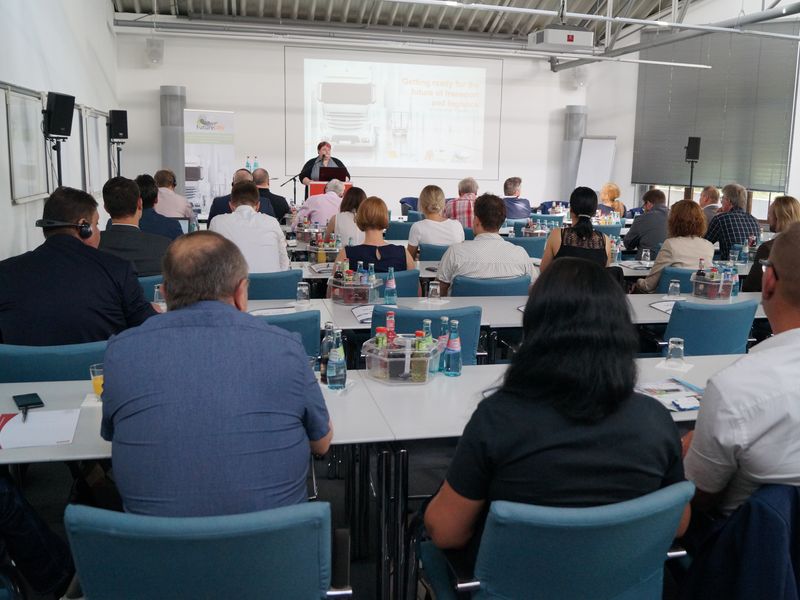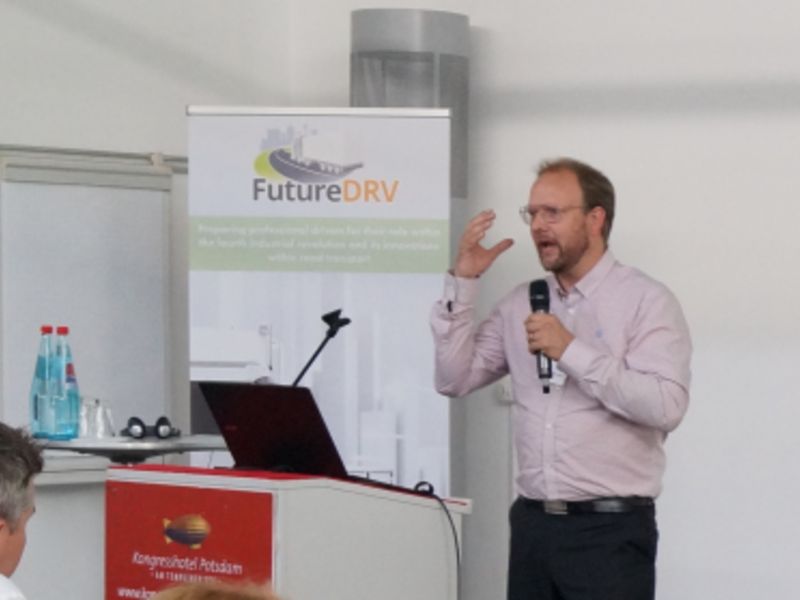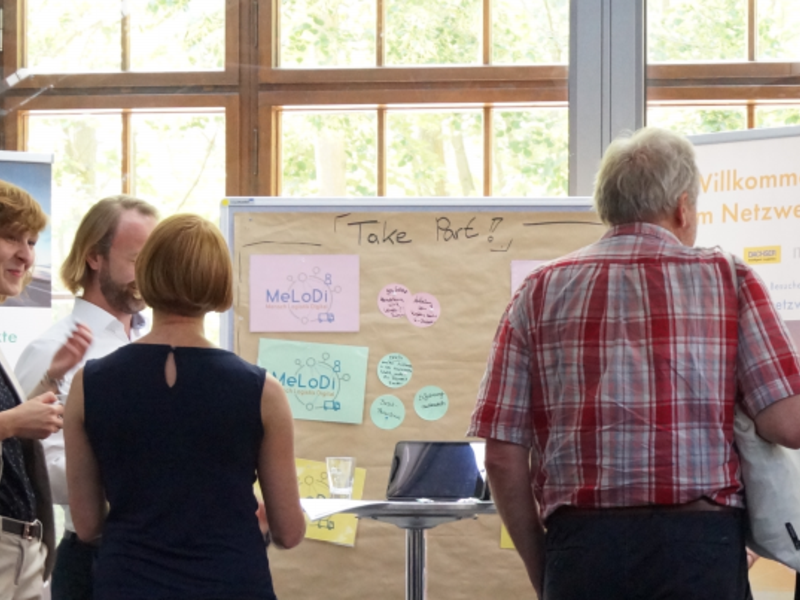FutureDRV final conference took place in Potsdam (DE)
On 12 June, 2019, the DEKRA-led, EU-funded educational research project, FutureDRV, hosted a conference, “Getting ready for the future of transport and logistics” at the Kongresshotel in Potsdam. Here, the project team presented the results of nearly three years of research to participants, representing 21 organizations in 6 countries. These presentations led to an exciting discussion of the future of the transport industry and what it means for everyone involved in it.
The conference was also a chance for two of DEKRA’s other educational research projects, MeLoDi and LaSiDig, to show how digital learning solutions can influence this future.
Participants were aware that digitalization and the rise of autonomous vehicles present very real challenges and opportunities for the industry in the coming decades. The accompanying risks for the drivers, such as under-qualification and unemployment, are also risks for society.
However, the FutureDRV conference concluded that the future can be shaped rather than passively accepted, and that the future of the profession goes hand in hand with the future of learning. If government, industry and the drivers themselves invest in innovative career development, these challenges can be met.
The Future: Challenges and Opportunities.
Claudia Ball, Head of Service Development in the Service Division Training, kicked off the event with a welcome on behalf of the project consortium – DEKRA Akademie GmbH and DEKRA SE in Germany, DEKRA Akademie Kft. in Hungary, 3s research laboratory in Austria, StageIT in Sweden, AFT in France and Transformotion in the UK.
Claudia also showed where FuturDRV stood in the context of related research projects:
- ProfDRV, which studied the qualification requirements and vocational training for professional drivers in Europe from 2010-2013, and
- ICTDRV, which studied how technology influences training within the driving profession
- FutureDRV, which investigated the future of professional driving from 2016-2019
- Steer to CareerDRV, which, from 2018-2021 will focus on developing curricula and professional learning programmes to help companies prepare drivers for this future
Sabine Schwenk from 3s presented the project results, which were developed out of extensive interviews and a Delphi study with experts in the field. The project asked how professional driving will look in 2035. A real possibility is that 2035 will see what is known as “Level Four – High Automation” where autonomous systems are prevalent, but drivers still play a significant role, especially in short distance and last mile delivery. This is illustrated in the videos prepared by the project below:
The view in the future was followed by an overview of technological innovation within transport from Moncef Semichi with AFT in France, covering vehicle to vehicle communication, remote diagnostics, automated driving, value chain integration and platforms connecting supply and demand”. Moncef pointed out that “it’s not because innovations are available that they will be spotted on the road. What is needed is action from the stakeholders: drivers increasing digital skills for new occupations and new competencies, as well as infrastructure and legislation from the state and the operational choices of the industry.”
The challenges that this future could bring were then discussed in a panel moderated by Claudia Ball. The panel included:
- Matthias Ball of DEKRA SE, Service Division training, himself a former professional driver and driver trainer
- John Bowman of RTITB, which sets the industry standards for transport training in the UK
- Dr. Heinz Högelsberger of the Arbeitskammer in Wien, AT
- Ralph Werner of ver.di. in Germany
- Niko Zdravkovic of the logistics company DACHSER, SE
While the panel represented different areas of the industry, they all believed the challenges of the digital future could be difficult to overcome for low-skilled drivers. However, if industry, government and the drivers themselves invest in the qualification – “enriching the mix of skills for the driver,” as John Bowman put it – then the chances increase for the driver and dangers such as mass unemployment, which could accompany autonomous driving, can be overcome.
When Matthias Ball was asked if he would choose to become a driver today, he said he would only do so on a career path where he could develop his professional skills.
Managing the Transition
The second half of the conference gave members an inside look at how innovation in training can shape the future of transport and logistics.
After the lunch break, Andréas Silfverberg from StageIT in Sweden gave a fascinating presentation on digital training approaches and learning within the driver profession. His own experience showed that in spite of resistance in the branch, digital training and gamification were accepted, enjoyed and effective once they were tried. Andreas, who also supports Service Division Training in preparing the new e-mobility training with his expertise, hopes “that the future will bring a lot more blended learning (combination of digital training, classroom and practical training) … which is not only motivating, but it produces a proud feeling in the driver – a feeling that they have accomplished something good.”
Sabine Schnittspahn and Lisa Marie Lorenz of DEKRA SE, Service Division Training, presented the aforementioned research project MeLoDi. Here, a team of researchers led by DEKRA are developing the prototype of digital platform, which will serve as an open training network where transport workers and companies can exchange ideas and best practices. Sabine explained, “we don’t need to reinvent the wheel for digital training, but we want people to be able to use effectively what’s already there. It’s about bundling resources and energy.”
Afterwards, Lukas Stranger of Nekonata XR Technologies in Austria a mixed reality training platform for professional drivers. Lukas argued that most people are not actually technology-averse. Rather, their hearts can be won by gamification. Indeed, he even explained how his company overcomes the problem of motion sickness in mixed reality!
James Tillyer of Transformortion in the UK presented the plan for Steer to CareerDRV, which will continue where FutureDRV leaves off in developing career pathways for professional drivers.
Finally, Joanna Burchert and Erik Funke of DEKRA SE, Service Division Training, presented the LaSiDig project as a solution for mobile learning for mobile workers. LaSiDig is a digital learning platform for load security, an important aspect for transport professionals. The platform, which Erik presented and allowed conference visitors to interact with, can be viewed here.
Conclusion
In her closing remarks, Claudia Ball once again pointed out that though there are risks for drivers, there are real possibilities, and government, industry and drivers don’t need to sit back and simply react to the market, but they can shape it through participation and support. In the final months of the project, FutureDRV will develop recommendations so that all of these stakeholders can shape the future. These final results are expected in the fall of 2019.



